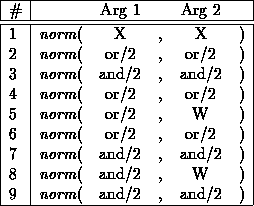The following part of a PROLOG program![]() (a normalizer producing DNFs of propositional formulas) is
used to demonstrate our heuristics for generating index trees:
(a normalizer producing DNFs of propositional formulas) is
used to demonstrate our heuristics for generating index trees:
norm(X, X) :- literal(X).
norm(or(X, Y), or(X, Y)) :- literal(X), literal(Y).
norm(and(X, Y), and(X, Y)) :- literal(X), literal(Y).
norm(or(X, Y), or(X1, Y)) :-
literal(Y),
norm(X, X1).
norm(or(X, or(Y, Z)), W) :-
norm(or(or(X, Y), Z), W).
norm(or(X, and(Y1, Y2)), or(X1, Y12)) :-
norm(X, X1),
norm(and(Y1, Y2), Y12).
norm(and(X, Y), and(X1, Y)) :-
literal(Y),
norm(X, X1).
norm(and(X, and(Y, Z)), W) :-
norm(and(and(X, Y), Z), W).
norm(and(X, or(Y1, Y2)), and(X1, Y12)) :-
norm(X, X1),
norm(or(Y1, Y2), Y12).
Only the following information (entirely extracted from the clause heads![]() )
is used for the index tree generation; all algorithms in this paper can
easily be extended to use additional information such as inner
structure arguments and ``guards''
)
is used for the index tree generation; all algorithms in this paper can
easily be extended to use additional information such as inner
structure arguments and ``guards''![]() (see section 12.1):
(see section 12.1):

The following sections describe the heuristics for our indexing techniques: